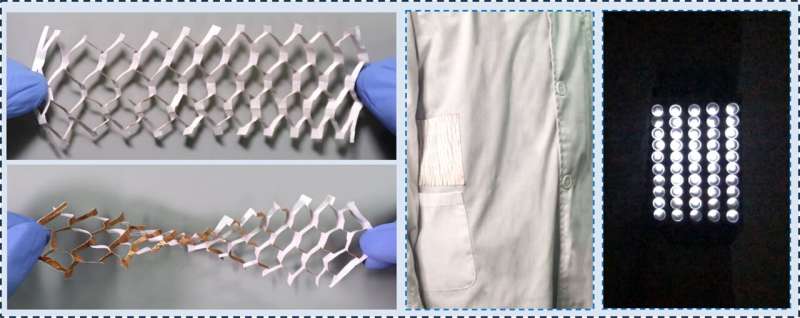
There is a lot of mechanical energy in human activities, but human activities are low frequency and irregular. As such, traditional electromagnetic power generation mode cannot efficiently collect this energy without affecting the normal activities of the human body.
A new energy harvesting method, called triboelectric nanogenerator (TENG), can efficiently collect low-frequency and irregular mechanical energy such as mechanical vibration, sound waves, raindrops, and so on. But there’s a catch: Achieving the flexibility, stretchability, and wearability of the TENG is a prerequisite for harvesting energy from the human body. Therefore, the scientists’ mission is to make the TENG wearable.
Current methods for achieving TENG flexibility and stretchability mostly rely on the properties of the material itself.
As a solution, a team of Chinese scientists applied the art of paper-cutting to the development of TENG. They created a stretchable, breathable, and wearable TENG based on non-stretchable materials using paper-cutting methods.
The wearable TENG is expected to extend the standby time of electronic devices and even enable self-powering. The in-situ energy solution for wearable electronics has great application prospects in the field of wearable electronic devices.
Prof. Kai Dong said, “Power supply is the bottleneck in the development of wearable electronic devices. At present, wearable electronic devices usually rely on traditional chemical batteries for energy supply, which limits the sustainability of wearable electronics. Harvesting human motion energy to supply wearable electronic devices is an ideal way to realize in-situ power solutions.”
“Triboelectric nanogenerator (TENG) is a new energy conversion technology that can efficiently convert the mechanical energy of human movement into electrical energy. Wearable electronics are advancing toward miniaturization and flexibility. The wearable TENG, as a power supply, is in line with the development trend of wearable electronics.”
“They can convert the mechanical energy of the human body’s daily activities into electrical energy to extend the battery life of electronic products and even achieve self-powered, which is expected to change the form of energy supply of wearable electronic products in the future.”
This technology is expected to promote the development of wearable electronic products and develop green and convenient energy supply methods.
























